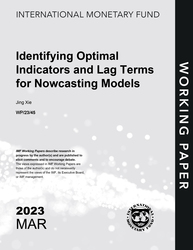
Identifying Optimal Indicators and Lag Terms for Nowcasting Models
Identifying Optimal Indicators and Lag Terms for Nowcasting Models
READ MORE...
Volume/Issue:
Volume 2023
Issue 045
Publication date: March 2023
ISBN: 9798400235177
$20.00
Add to Cart by clicking price of the language and format you'd like to purchase
Available Languages and Formats
| English |
Prices in red indicate formats that are not yet available but are forthcoming.
Topics covered in this book
This title contains information about the following subjects.
Click on a subject if you would like to see other titles with the same subjects.
Economics- Macroeconomics , Economics / General , Nowcasting , Mixed Frequency , Forecasting , Business Cycles , selection procedure , Annex I , AS-ARIMAX procedure , nowcasting method , evaluation comparison , baseline model , Global
Also of interest
Summary
Many central banks and government agencies use nowcasting techniques to obtain policy relevant information about the business cycle. Existing nowcasting methods, however, have two critical shortcomings for this purpose. First, in contrast to machine-learning models, they do not provide much if any guidance on selecting the best explantory variables (both high- and low-frequency indicators) from the (typically) larger set of variables available to the nowcaster. Second, in addition to the selection of explanatory variables, the order of the autoregression and moving average terms to use in the baseline nowcasting regression is often set arbitrarily. This paper proposes a simple procedure that simultaneously selects the optimal indicators and ARIMA(p,q) terms for the baseline nowcasting regression. The proposed AS-ARIMAX (Adjusted Stepwise Autoregressive Moving Average methods with exogenous variables) approach significantly reduces out-of-sample root mean square error for nowcasts of real GDP of six countries, including India, Argentina, Australia, South Africa, the United Kingdom, and the United States.
Copyright © 2010 - 2026
Powered by:
AIDC



